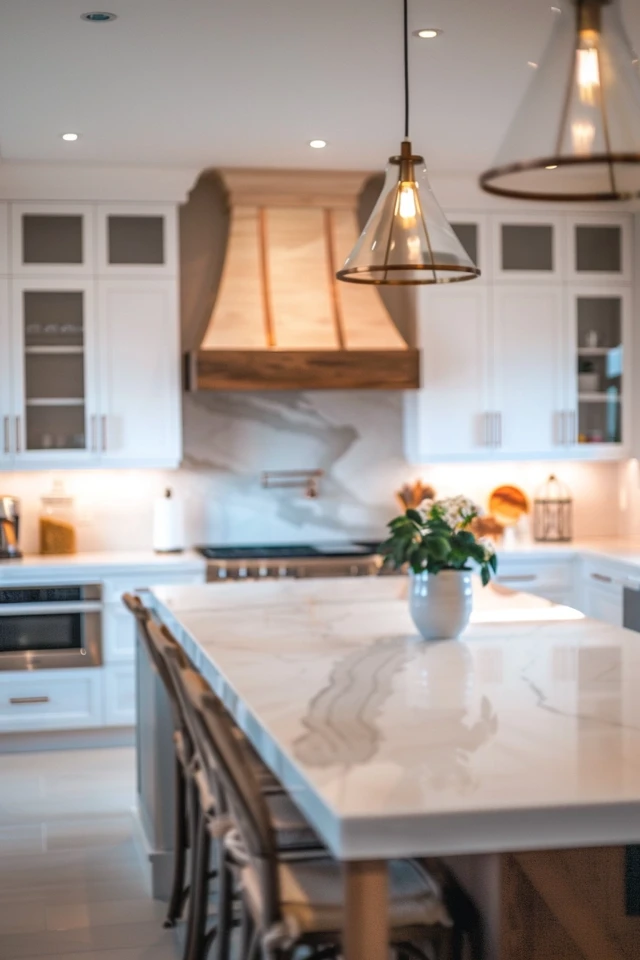A well-designed kitchen is like a symphony, where every element works in harmony to create a beautiful and functional space. When it comes to matching kitchen cabinets, countertops, and flooring, careful consideration and thoughtful coordination are essential. In this article, I will guide you through the process of achieving perfect coordination in your kitchen design, from choosing the right materials to creating a cohesive color scheme.
Key Takeaways:
- Consider the core aesthetics when choosing kitchen materials and elements.
- Play with textures and materials to achieve visual harmony.
- Create depth and visual interest through color and contrast.
- Coordinate cabinet styles and flooring to enhance the overall design.
- Practical considerations such as durability and natural light are important factors in harmonizing your kitchen.
Understanding the Core Aesthetics and Playing with Textures and Materials
A well-coordinated kitchen design begins with a profound understanding of aesthetics. As I embark on my journey to harmonize my kitchen, I realize the importance of establishing a cohesive color palette that complements the overall theme. But it doesn’t stop there. To truly achieve synergy in my kitchen design, I need to explore the tactile qualities of countertops, cabinets, and flooring – playing with textures and materials to create a visually stunning and functional space.
When it comes to countertops, cabinets, and flooring, each element brings its own unique character. By strategically pairing these elements, I can elevate the visual impact of my kitchen. For a modern look, I envision sleek and polished countertops adorned with glossy cabinet finishes and shiny flooring. This combination exudes a sense of sophistication and contemporary elegance.
However, if I desire a warm and inviting atmosphere, I can opt for textured surfaces that offer a tactile experience. By incorporating natural wood elements, I can balance the smoothness of the countertops and cabinets, creating a harmonious blend of textures that adds depth and character to my kitchen.

Exploring various materials for countertops, cabinets, and flooring is an exciting venture. From granite and marble to quartz and laminate, the possibilities are endless when it comes to selecting the perfect materials for my kitchen. Each material has its own unique qualities, from durability to aesthetics. By carefully considering these factors, I can ensure that my kitchen not only looks stunning but also withstands the test of time.
In my pursuit of a well-coordinated kitchen design, I realize that understanding the core aesthetics and playing with textures and materials are essential. It is through this exploration that I can achieve a space that not only visually captivates but also reflects my personal style and elevates my culinary experiences.
Creating Depth with Color and Harnessing the Power of Contrast
In the realm of kitchen design, color and contrast are powerful tools that can elevate the aesthetics of your space. By skillfully incorporating a mix of light and dark tones, you can achieve depth and visual interest in your kitchen.
One way to create depth is by juxtaposing dark countertops with lighter cabinets and flooring. This contrast adds dimension to your kitchen, making it appear more spacious and dynamic. The bright cabinets and flooring act as a canvas for the darker countertops to shine, creating a stunning visual effect.
For those who prefer a monochromatic scheme, variations in shades can be used to enhance the depth. By incorporating subtle tonal differences in the countertops, cabinets, and flooring, you can add layers of intrigue to your kitchen design. The play of light and shadow on these variations creates a sense of depth and texture.

Contrast: A Key Element
“Contrast is the secret ingredient that breathes life into your kitchen design. It can be achieved not only through color but also through texture.” – Interior Designer Jane Thompson
Contrast in kitchen design is not limited to color; it can also be achieved through texture. Pairing light cabinets with dark countertops or integrating sleek countertops with rustic cabinets creates a captivating juxtaposition of sleekness and natural warmth. This contrast not only adds visual impact but also brings a sense of balance and harmony to your kitchen.
Whether you choose to create depth with color or harness the power of contrast through texture, the result will be a visually stunning and harmonized kitchen space.

Conclusion
Matching your kitchen cabinets, countertops, and flooring is essential for achieving a harmonious and visually appealing kitchen design. By taking into account core aesthetics, playing with textures and materials, creating depth with color, and harnessing the power of contrast, you can create a kitchen space that reflects your personal style and facilitates seamless culinary experiences.
When considering the core aesthetics, it’s important to establish a cohesive color palette that complements your overall kitchen theme. Playing with textures and materials allows you to create a synergy between your countertops, cabinets, and flooring, whether it’s pairing sleek, polished surfaces with glossy finishes or balancing textured elements with natural wood accents.
Creating depth in your kitchen design can be achieved through color and contrast. Experimenting with a combination of light and dark tones can add visual interest, such as pairing dark countertops with lighter cabinets and flooring. Monochromatic schemes can also be enhanced with subtle variations in shades. Additionally, harnessing contrast, whether through color or texture, can bring life to your kitchen, such as combining light cabinets with dark countertops or sleek surfaces with rustic cabinets.
Practical considerations should not be overlooked when harmonizing your kitchen. Durability and maximum natural light are key factors to consider when selecting materials. By paying careful attention to detail and thoughtfully coordinating your kitchen elements, you can create a space that not only looks visually appealing but also functions seamlessly for your culinary endeavors.
Source Links
- https://www.millercarpetone.com/blog/articles/how-to-match-countertops-with-kitchen-cabinets-and-flooring
- https://marbleandtileusa.com/blogs/blogs/the-ultimate-guide-to-matching-your-kitchen-countertops-cabinets-and-flooring
- https://cassonhardware.com/blogs/stories/kitchen-design-and-matching-finishes-guide

